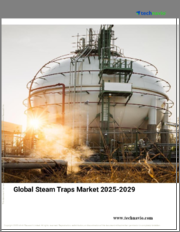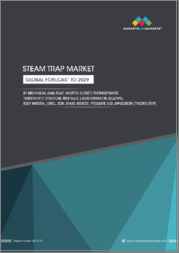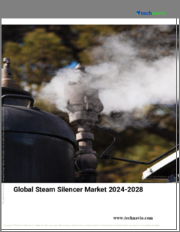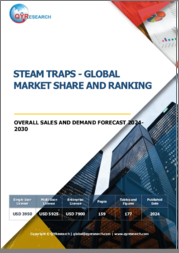
|
시장보고서
상품코드
1642500
스팀 트랩 시장 보고서 : 제품 유형별, 용도별, 재료 유형별, 유통 채널별, 최종 이용 산업별, 지역별(2025-2033년)Steam Trap Market Report by Product Type, Application, Material Type, Distribution Channel, End-Use Industry, and Region 2025-2033 |
||||||
세계의 스팀 트랩 시장 규모는 2024년 46억 달러에 달했습니다. IMARC Group은 향후 2033년까지 시장이 62억 달러에 달할 전망이며, 2025년부터 2033년까지 3.4%의 성장률(CAGR)을 나타낼 것으로 예측했습니다. 이 시장은 환경 의식 증가, 에너지 비용 상승, 산업 분야 확대 및 공정 최적화 수요, 안전성, 배출 가스, 에너지 효율과 관련된 엄격한 규제 기준 및 가이드라인 도입 등으로 안정적인 성장을 이루고 있습니다.
스팀 트랩 시장 내역 :
시장 성장 및 규모 : 에너지 효율적인 솔루션에 대한 수요가 증가함에 따라 시장은 꾸준히 성장하고 있습니다. 또한 지속가능성과 환경에 대한 관심 증가가 시장 성장을 뒷받침하고 있습니다.
기술 진보 : 기술 혁신은 보다 효율적이고 신뢰할 수 있는 스팀 트랩 솔루션의 개발로 이어져 시장 성장에 기여하고 있습니다.
산업 용도 : 스팀 트랩은 효율적인 증기 관리의 역할을 하기 위해 석유 및 가스, 화학, 식품가공, 발전 등 다양한 산업에서 응용되고 있습니다.
지리적 동향 : 아시아태평양은 다양한 산업에서 스팀 트랩 수요 증가로 시장을 선도하고 있습니다. 그러나 북미는 산업 시설의 에너지 효율과 공정 최적화의 필요성이 높아짐에 따라 급성장 시장으로 부상하고 있습니다.
경쟁 구도 : 시장 경쟁이 치열해지고 있으며, 여러 주요 기업들이 혁신과 경쟁력 있는 가격 설정으로 시장 점유율을 경쟁하고 있습니다. 이러한 기업들은 또한 에너지 효율적인 솔루션에 대한 수요 증가에 부응하기 위해 노력하고 있습니다.
과제 및 기회 : 지속적인 유지 보수 필요성과 스팀 트랩 고장의 가능성과 같은 과제에 직면하는 한편, 유지 보수 서비스 제공 업체 및 신뢰성 문제를 해결하는 혁신적인 솔루션과 같은 기회를 만날 수 있습니다.
미래 전망 : 산업계가 에너지 효율에 주력하고 있기 때문에 스팀 트랩 시장의 미래는 유망합니다. 이 시장은 기술의 진보와 에너지 절약 의식의 높아짐에 따라 추가 성장이 예상됩니다.
스팀 트랩 시장 동향 :
에너지 효율의 중요성
에너지 비용 상승으로 인한 환경 의식 증가는 시장 성장을 지원하는 중요한 요소 중 하나입니다. 스팀 트랩은 스팀 시스템이 최상의 효율 수준에서 작동하는지 확인하는 데 매우 중요한 역할을 합니다. 증기 라인에서 응축수와 비응축성 가스를 효과적으로 제거함으로써 스팀 트랩은 에너지 낭비를 방지하고 연료 소비를 줄이고 온실 가스 배출을 줄입니다. 이는 세계의 지속가능성 목표와 이산화탄소 배출량을 줄이기 위한 규제의 의무에 따른 것입니다. 제조업에서 건강 관리에 이르기까지 에너지 효율적인 솔루션에 대한 투자가 증가하고 있으며, 스팀 트랩은 지속가능성 전략의 중요한 요소가 되었습니다. 이러한 에너지 절약에 대한 주목은 최신의 스팀 트랩 기술에 대한 수요를 높일 뿐만 아니라, 그 효율을 높이기 위한 연구개발 활동에도 박차를 가하고 있습니다.
산업 확대 및 프로세스 최적화
산업 부문의 확대와 공정 최적화에 대한 수요가 시장 성장을 가속하고 있습니다. 산업이 발전함에 따라 안정적이고 효율적인 증기 시스템에 대한 수요가 증가하고 있습니다. 증기는 제조, 발전, 화학 생산 등 다양한 산업 공정에서 중요한 요소입니다. 산업계는 장비 손상과 공정 효율 저하로 이어지는 드레인의 축적을 방지하기 위해 스팀 트랩에 의존합니다. 또한 산업계가 비용 절감과 제품 품질 향상을 위해 생산 공정을 최적화하기 위해 노력하고 있기 때문에 스팀 트랩의 역할이 더욱 중요해지고 있습니다. 스팀 트랩은 안정적인 증기 압력과 온도를 유지하며 더 나은 공정 제어와 전반적인 작동 효율에 기여합니다. 그 결과 산업이 확대되고 공정 개선이 요구됨에 따라 스팀 트랩 수요가 증가하고 있습니다.
엄격한 규제 기준
안전, 배출 및 에너지 효율과 관련된 엄격한 규제 기준 및 지침의 구현은 시장 성장을 가속하고 있습니다. 세계 정부와 산업 단체는 산업 공정에서 에너지 소비와 배출을 줄이는 데 점점 더 많은 노력을 기울이고 있습니다. 스팀 트랩은 스팀 시스템을 효율적으로 관리함으로써 이러한 목표를 달성하는 데 중요한 역할을 합니다. 규제기관은 종종 특정 에너지 효율 및 배출 감축 목표를 준수하도록 산업계에 요구하고 있으므로 비효율적인 증기 시스템과 관련된 증기 손실을 방지하고 온실 가스 배출을 줄이기 위해 고급 스팀 트랩을 사용해야 합니다. 또한, 안전 규제에서는 사고를 방지하기 위해 증기 장치의 적절한 작동이 요구되며, 스팀 트랩은 컴플라이언스에 필수적인 요소입니다.
유지 보수 비용 절감
산업의 증기 시스템은 효율적으로 작동하기 위해 일관된 유지 보수가 필요합니다. 스팀 트랩이 비효율적이거나 고장나면 장비 손상 및 유지보수 요구 사항이 증가하게 됩니다. 드레인을 효과적으로 제거하고 증기 누출을 방지하는 고품질 스팀 트랩에 투자함으로써 산업계는 유지 보수 비용을 크게 줄일 수 있습니다. 이러한 최신 스팀 트랩은 내구성과 수명이 길고 교체 및 수리 빈도를 최소화하도록 설계되었습니다. 또한 스마트 스팀 트랩의 데이터에 의존하는 예지 보전과 같은 첨단 기술을 사용하면 적시에 개입이 가능하고 비용이 많이 드는 고장을 방지하여 유지 보수 비용을 더욱 줄일 수 있습니다.
목차
제1장 서문
제2장 조사 범위 및 조사 방법
- 조사의 목적
- 이해관계자
- 데이터 소스
- 1차 정보
- 2차 정보
- 시장 추정
- 상향식 접근
- 하향식 접근
- 조사 방법
제3장 주요 요약
제4장 서문
- 개요
- 주요 업계 동향
제5장 세계의 스팀 트랩 시장
- 시장 개요
- 시장 실적
- COVID-19의 영향
- 시장 예측
제6장 시장 내역 : 제품 유형별
- 열역학식
- 시장 동향
- 시장 예측
- 기계식
- 시장 동향
- 시장 예측
- 서모스탯 식
- 시장 동향
- 시장 예측
제7장 시장 내역 : 용도별
- 계기 증기 트레이스
- 시장 동향
- 시장 예측
- 라인 증기 트레이스
- 시장 동향
- 시장 예측
- 점적 도포
- 시장 동향
- 시장 예측
- 프로세스 용도
- 시장 동향
- 시장 예측
- 기타
- 시장 동향
- 시장 예측
제8장 시장 내역 : 재료 유형별
- 강철
- 시장 동향
- 시장 예측
- 철
- 시장 동향
- 시장 예측
- 기타
- 시장 동향
- 시장 예측
제9장 시장 내역 : 유통 채널별
- 온라인
- 시장 동향
- 시장 예측
- 오프라인
- 시장 동향
- 시장 예측
제10장 시장 내역 : 최종 이용 산업별
- 석유 및 가스
- 시장 동향
- 시장 예측
- 발전
- 시장 동향
- 시장 예측
- 의약품
- 시장 동향
- 시장 예측
- 식품 및 음료
- 시장 동향
- 시장 예측
- 펄프 및 종이
- 시장 동향
- 시장 예측
- 화학약품
- 시장 동향
- 시장 예측
- 기타
- 시장 동향
- 시장 예측
제11장 시장 내역 : 지역별
- 북미
- 미국
- 캐나다
- 아시아태평양
- 중국
- 일본
- 인도
- 한국
- 호주
- 인도네시아
- 기타
- 유럽
- 독일
- 프랑스
- 영국
- 이탈리아
- 스페인
- 러시아
- 기타
- 라틴아메리카
- 브라질
- 멕시코
- 기타
- 중동 및 아프리카
- 시장 동향
- 시장 내역 : 국가별
- 시장 예측
제12장 SWOT 분석
- 개요
- 강점
- 약점
- 기회
- 위협
제13장 밸류체인 분석
제14장 Porter's Five Forces 분석
- 개요
- 구매자의 협상력
- 공급기업의 협상력
- 경쟁도
- 신규 참가업체의 위협
- 대체품의 위협
제15장 가격 지표
제16장 경쟁 구도
- 시장 구조
- 주요 기업
- 주요 기업 프로파일
- Circor International Inc.
- Emerson Electric Co.
- Flowserve Corporation
- Pentair Inc.
- Schlumberger Limited
- Spirax-Sarco Engineering
- Thermax Ltd.
- Velan Inc.
- Watts Water Technologies Inc.
- The Weir Group PLC
The global steam trap market size reached USD 4.6 Billion in 2024. Looking forward, IMARC Group expects the market to reach USD 6.2 Billion by 2033, exhibiting a growth rate (CAGR) of 3.4% during 2025-2033. The market is experiencing stable growth driven by the growing environmental awareness, along with rising energy costs, expansion of industrial sectors and the demand for process optimization, and implementation of stringent regulatory standards and guidelines related to safety, emissions, and energy efficiency.
Steam Trap Market Analysis:
Market Growth and Size: The market is witnessing steady growth, driven by the increasing demand for energy-efficient solutions across industries. Additionally, the emphasis on sustainability and environmental concerns is impelling the market growth.
Technological Advancements: Technological innovations are leading to the development of more efficient and reliable steam trap solutions, contributing to the growth of the market.
Industry Applications: Steam traps find applications across various industries, including oil and gas, chemicals, food processing, and power generation, due to their role in efficient steam management.
Geographical Trends: Asia Pacific leads the market, driven by the increasing demand for steam traps across various industries. However, North America is emerging as a fast-growing market, driven by the rising need for energy efficiency and process optimization in industrial facilities.
Competitive Landscape: The market is characterized by intense competition with several key players, each vying for market share through innovation and competitive pricing. These companies are also striving to meet the growing demand for energy-efficient solutions.
Challenges and Opportunities: While the market faces challenges, such as the need for continuous maintenance and the potential for steam trap failure, it also encounters opportunities in maintenance service providers and innovative solutions to address reliability issues.
Future Outlook: The future of the steam trap market looks promising, with industries focusing on energy efficiency. The market is expected to witness further growth driven by technological advancements and increasing awareness of energy conservation.
Steam Trap Market Trends:
Energy efficiency imperative
The increasing environmental awareness, along with rising energy costs, represents one of the key factors supporting the growth of the market. Steam traps play a pivotal role in ensuring that steam systems operate at their highest efficiency levels. By effectively removing condensate and non-condensable gases from steam lines, steam traps prevent energy wastage, reduce fuel consumption, and lower greenhouse gas emissions. This aligns with global sustainability goals and regulatory mandates to reduce carbon footprints. Industries, ranging from manufacturing to healthcare, are increasingly investing in energy-efficient solutions, making steam traps a critical component of their sustainability strategies. This focus on energy conservation not only drives the demand for modern steam trap technologies but also fuels ongoing research and development (R&D) activities to enhance their efficiency.
Industrial expansion and process optimization
The expansion of industrial sectors and the demand for process optimization are propelling the growth of the market. As industries are evolving, there is a growing demand for reliable and efficient steam systems. Steam is a critical component in various industrial processes, including manufacturing, power generation, and chemical production. Industries rely on steam traps to prevent condensate buildup, which can lead to equipment damage and reduced process efficiency. Moreover, as industries are striving to optimize their production processes to reduce costs and improve product quality, the role of steam traps becomes even more essential. They aid in maintaining consistent steam pressure and temperature, contributing to better process control and overall operational efficiency. Consequently, as industries are expanding and seeking process improvements, the demand for steam traps is rising.
Stringent regulatory standards
The implementation of stringent regulatory standards and guidelines related to safety, emissions, and energy efficiency is impelling the market growth. Governments and industry organizations worldwide are increasingly focusing on reducing energy consumption and emissions in industrial processes. Steam traps play a critical role in achieving these objectives by efficiently managing steam systems. Regulatory bodies often require industries to adhere to specific energy efficiency and emissions reduction targets, which necessitate the use of advanced steam traps to prevent steam loss and reduce greenhouse gas emissions associated with inefficient steam systems. Moreover, safety regulations mandate the proper operation of steam equipment to prevent accidents, making steam traps a crucial component for compliance.
Maintenance cost reduction
Steam systems in industries require consistent maintenance to operate efficiently. Inefficient or failed steam traps can lead to equipment damage and increased maintenance requirements. By investing in high-quality steam traps that effectively remove condensate and prevent steam leaks, industries can significantly reduce their maintenance expenses. These modern steam traps are designed for durability and longevity, minimizing the frequency of replacements or repairs. Additionally, the use of advanced technologies like predictive maintenance, which relies on data from smart steam traps, further reduces maintenance costs by allowing for timely interventions and preventing costly breakdowns.
Steam Trap Industry Segmentation:
Breakup by Product Type:
Thermodynamic
Mechanical
Thermostatic
Mechanical accounts for the majority of the market share
Breakup by Application:
Instrument Steam Tracing
Line Steam Tracing
Drip Application
Process Application
Others
Breakup by Material Type:
Steel
Iron
Others
Steel represents the leading market segment
Breakup by Distribution Channel:
Online
Offline
Breakup by End-Use Industry:
Oil and Gas
Power Generation
Pharmaceuticals
Food and Beverages
Pulp and Paper
Chemical
Others
Oil and gas exhibit a clear dominance
Breakup by Region:
North America
United States
Canada
Asia Pacific
China
Japan
India
South Korea
Australia
Indonesia
Others
Europe
Germany
France
United Kingdom
Italy
Spain
Russia
Others
Latin America
Brazil
Mexico
Others
Middle East and Africa
Asia Pacific leads the market, accounting for the largest steam trap market share
The market research report has also provided a comprehensive analysis of all the major regional markets, which include North America (the United States and Canada); Asia Pacific (China, Japan, India, South Korea, Australia, Indonesia, and others); Europe (Germany, France, the United Kingdom, Italy, Spain, Russia, and others); Latin America (Brazil, Mexico, and others); and the Middle East and Africa. According to the report, Asia Pacific accounted for the largest market share due to the increasing demand for steam traps across various industries. The thriving manufacturing sector, coupled with a focus on energy efficiency and sustainability, is driving the adoption of advanced steam trap technologies in the region. Additionally, the expanding infrastructure and investments in power generation is contributing to the market growth in the region.
The market research report has provided a comprehensive analysis of the competitive landscape. Detailed profiles of all major companies have also been provided. Some of the key players in the market include:
Circor International Inc.
Emerson Electric Co.
Flowserve Corporation
Pentair Inc.
Schlumberger Limited
Spirax-Sarco Engineering
Thermax Ltd.
Velan Inc.
Watts Water Technologies Inc.
The Weir Group PLC
Key Questions Answered in This Report
- 1. What will be the global steam trap market outlook during the forecast period 2025-2033?
- 2. What are the global steam trap market drivers?
- 3. What are the major trends in the global steam trap market?
- 4. What is the impact of COVID-19 on the global steam trap market?
- 5. What is the global steam trap market breakup by application?
- 6. What is the global steam trap market breakup by material type?
- 7. What is the global steam trap market breakup by end-use industry?
- 8. What are the major regions in the global steam trap market?
Table of Contents
1 Preface
2 Scope and Methodology
- 2.1 Objectives of the Study
- 2.2 Stakeholders
- 2.3 Data Sources
- 2.3.1 Primary Sources
- 2.3.2 Secondary Sources
- 2.4 Market Estimation
- 2.4.1 Bottom-Up Approach
- 2.4.2 Top-Down Approach
- 2.5 Forecasting Methodology
3 Executive Summary
4 Introduction
- 4.1 Overview
- 4.2 Key Industry Trends
5 Global Steam Trap Market
- 5.1 Market Overview
- 5.2 Market Performance
- 5.3 Impact of COVID-19
- 5.4 Market Forecast
6 Market Breakup by Product Type
- 6.1 Thermodynamic
- 6.1.1 Market Trends
- 6.1.2 Market Forecast
- 6.2 Mechanical
- 6.2.1 Market Trends
- 6.2.2 Market Forecast
- 6.3 Thermostatic
- 6.3.1 Market Trends
- 6.3.2 Market Forecast
7 Market Breakup by Application
- 7.1 Instrument Steam Tracing
- 7.1.1 Market Trends
- 7.1.2 Market Forecast
- 7.2 Line Steam Tracing
- 7.2.1 Market Trends
- 7.2.2 Market Forecast
- 7.3 Drip Application
- 7.3.1 Market Trends
- 7.3.2 Market Forecast
- 7.4 Process Application
- 7.4.1 Market Trends
- 7.4.2 Market Forecast
- 7.5 Others
- 7.5.1 Market Trends
- 7.5.2 Market Forecast
8 Market Breakup by Material Type
- 8.1 Steel
- 8.1.1 Market Trends
- 8.1.2 Market Forecast
- 8.2 Iron
- 8.2.1 Market Trends
- 8.2.2 Market Forecast
- 8.3 Others
- 8.3.1 Market Trends
- 8.3.2 Market Forecast
9 Market Breakup by Distribution Channel
- 9.1 Online
- 9.1.1 Market Trends
- 9.1.2 Market Forecast
- 9.2 Offline
- 9.2.1 Market Trends
- 9.2.2 Market Forecast
10 Market Breakup by End-Use Industry
- 10.1 Oil & Gas
- 10.1.1 Market Trends
- 10.1.2 Market Forecast
- 10.2 Power Generation
- 10.2.1 Market Trends
- 10.2.2 Market Forecast
- 10.3 Pharmaceuticals
- 10.3.1 Market Trends
- 10.3.2 Market Forecast
- 10.4 Food & Beverages
- 10.4.1 Market Trends
- 10.4.2 Market Forecast
- 10.5 Pulp & Paper
- 10.5.1 Market Trends
- 10.5.2 Market Forecast
- 10.6 Chemical
- 10.6.1 Market Trends
- 10.6.2 Market Forecast
- 10.7 Others
- 10.7.1 Market Trends
- 10.7.2 Market Forecast
11 Market Breakup by Region
- 11.1 North America
- 11.1.1 United States
- 11.1.1.1 Market Trends
- 11.1.1.2 Market Forecast
- 11.1.2 Canada
- 11.1.2.1 Market Trends
- 11.1.2.2 Market Forecast
- 11.1.1 United States
- 11.2 Asia Pacific
- 11.2.1 China
- 11.2.1.1 Market Trends
- 11.2.1.2 Market Forecast
- 11.2.2 Japan
- 11.2.2.1 Market Trends
- 11.2.2.2 Market Forecast
- 11.2.3 India
- 11.2.3.1 Market Trends
- 11.2.3.2 Market Forecast
- 11.2.4 South Korea
- 11.2.4.1 Market Trends
- 11.2.4.2 Market Forecast
- 11.2.5 Australia
- 11.2.5.1 Market Trends
- 11.2.5.2 Market Forecast
- 11.2.6 Indonesia
- 11.2.6.1 Market Trends
- 11.2.6.2 Market Forecast
- 11.2.7 Others
- 11.2.7.1 Market Trends
- 11.2.7.2 Market Forecast
- 11.2.1 China
- 11.3 Europe
- 11.3.1 Germany
- 11.3.1.1 Market Trends
- 11.3.1.2 Market Forecast
- 11.3.2 France
- 11.3.2.1 Market Trends
- 11.3.2.2 Market Forecast
- 11.3.3 United Kingdom
- 11.3.3.1 Market Trends
- 11.3.3.2 Market Forecast
- 11.3.4 Italy
- 11.3.4.1 Market Trends
- 11.3.4.2 Market Forecast
- 11.3.5 Spain
- 11.3.5.1 Market Trends
- 11.3.5.2 Market Forecast
- 11.3.6 Russia
- 11.3.6.1 Market Trends
- 11.3.6.2 Market Forecast
- 11.3.7 Others
- 11.3.7.1 Market Trends
- 11.3.7.2 Market Forecast
- 11.3.1 Germany
- 11.4 Latin America
- 11.4.1 Brazil
- 11.4.1.1 Market Trends
- 11.4.1.2 Market Forecast
- 11.4.2 Mexico
- 11.4.2.1 Market Trends
- 11.4.2.2 Market Forecast
- 11.4.3 Others
- 11.4.3.1 Market Trends
- 11.4.3.2 Market Forecast
- 11.4.1 Brazil
- 11.5 Middle East and Africa
- 11.5.1 Market Trends
- 11.5.2 Market Breakup by Country
- 11.5.3 Market Forecast
12 SWOT Analysis
- 12.1 Overview
- 12.2 Strengths
- 12.3 Weaknesses
- 12.4 Opportunities
- 12.5 Threats
13 Value Chain Analysis
14 Porters Five Forces Analysis
- 14.1 Overview
- 14.2 Bargaining Power of Buyers
- 14.3 Bargaining Power of Suppliers
- 14.4 Degree of Competition
- 14.5 Threat of New Entrants
- 14.6 Threat of Substitutes
15 Price Indicators
16 Competitive Landscape
- 16.1 Market Structure
- 16.2 Key Players
- 16.3 Profiles of Key Players
- 16.3.1 Circor International Inc.
- 16.3.1.1 Company Overview
- 16.3.1.2 Product Portfolio
- 16.3.1.3 Financials
- 16.3.1.4 SWOT Analysis
- 16.3.2 Emerson Electric Co.
- 16.3.2.1 Company Overview
- 16.3.2.2 Product Portfolio
- 16.3.2.3 Financials
- 16.3.2.4 SWOT Analysis
- 16.3.3 Flowserve Corporation
- 16.3.3.1 Company Overview
- 16.3.3.2 Product Portfolio
- 16.3.3.3 Financials
- 16.3.3.4 SWOT Analysis
- 16.3.4 Pentair Inc.
- 16.3.4.1 Company Overview
- 16.3.4.2 Product Portfolio
- 16.3.5 Schlumberger Limited
- 16.3.5.1 Company Overview
- 16.3.5.2 Product Portfolio
- 16.3.5.3 Financials
- 16.3.5.4 SWOT Analysis
- 16.3.6 Spirax-Sarco Engineering
- 16.3.6.1 Company Overview
- 16.3.6.2 Product Portfolio
- 16.3.6.3 Financials
- 16.3.6.4 SWOT Analysis
- 16.3.7 Thermax Ltd.
- 16.3.7.1 Company Overview
- 16.3.7.2 Product Portfolio
- 16.3.7.3 Financials
- 16.3.8 Velan Inc.
- 16.3.8.1 Company Overview
- 16.3.8.2 Product Portfolio
- 16.3.8.3 Financials
- 16.3.8.4 SWOT Analysis
- 16.3.9 Watts Water Technologies Inc.
- 16.3.9.1 Company Overview
- 16.3.9.2 Product Portfolio
- 16.3.9.3 Financials
- 16.3.10 The Weir Group PLC
- 16.3.10.1 Company Overview
- 16.3.10.2 Product Portfolio
- 16.3.10.3 Financials
- 16.3.1 Circor International Inc.



















